
Oyster mushrooms, scientifically known as Pleurotus spp. are delicious, full of flavor and considered a medicinal food. There are so many awesome varieties, and they all have a difference in taste, smell and consistency.
There are around 202 edible species within the pleurotus family, with Pearl oysters being the most common in North America. Having a woody almost nutty flavor with a slightly soft and chewy texture. On the other hand, some oyster mushrooms have a slightly seafoody taste and smell, like the Pink oyster, and go well with seafood dishes.
Officially documented and classified by Dutch naturalist Niklaus Joseph Freiherr Von Jacquin in 1775 as Agaricus ostreatus. Later, in 1871 German Mycologist, Paul Kummer, reclassified them as genus Pleurotus. Coined as the “oyster” mushroom due to its seashell appearance.
Oyster mushrooms eventually began being commercially cultivated around the 1940’s for the local markets, restaurants and medicinal uses.
Oyster Mushroom Medicinal Properties

Oyster mushrooms are known for their medicinal benefits like general nutrition and heart health, but did you know that they are also great at helping reduce inflammation and reducing cholesterol and aiding in weight loss?
The beta- glucans, antioxidants and ergothioneine amino acids help to protect the heart and lower inflammation throughout the whole body. Mushrooms are one of the only food products that naturally contain vitamin D, which helps to regulate blood pressure levels. This is beneficial to people that live in colder climates that tend to be deficient in vitamin D.
Another interesting fact about the beta-glucans that mushrooms produce, makes them one of the best foods on the planet for protecting your immune system against short term and long term illnesses. Mushrooms also make a great vegan-cholesterol friendly replacement for meat in any dish! Packed with protein and loads of vitamins.
Did you know that one cup of oyster mushrooms gives you 12% of your recommended iron intake? Oyster mushrooms are also rich in riboflavin, potassium, vitamin B6, magnesium and other amino acids.
Foraging for Oyster Mushrooms
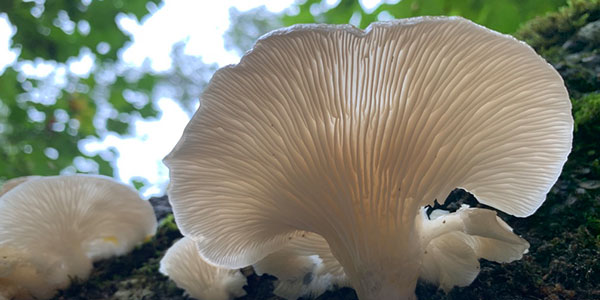
In the wild, you can forage for oyster mushrooms all year long. Fallen trees and logs, such as beech, oak, sycamore or other types of hardwood are where the oyster mushrooms like to form in clusters, called shelves. With the exception of the King Oyster mushroom. This one tends to grow individually, with thick white, meaty stalks and tan colored caps. King Oyster is not native to the US.
Oyster Mushroom Lookalikes
There are some mushrooms that are oyster look-alikes and are poisonous.
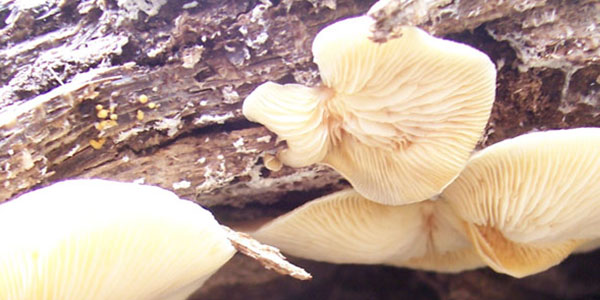
Crepidotus applanatus – thin and small fruiting bodies with a flat growing habit, the stalk is absent, typically not fruiting in clusters, may fuse with one or two, has a brown sporeprint.
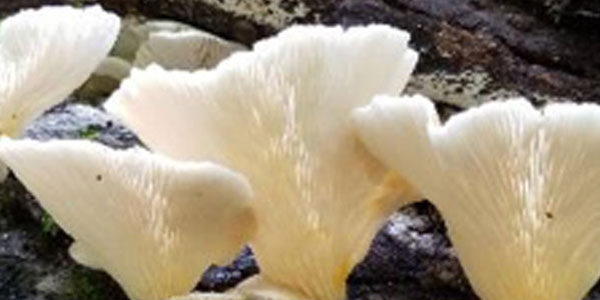
Pleurocybella porrigens – The Angel Wing – thin and small fruiting body, typically not clustering, fragile caps that crack and/or crumble easily, grows on conifers, has a white sporeprint.

Omphalotus illudens – The Jack-o’Lantern – sometimes mistaken for chanterelles but is more closely related to the oyster mushroom. Deep bladed, non forking gills, clustering on wood or base of trees, sometimes on buried wood or roots, orange interior flesh color, may be lighter when mushrooms are young. Not considered fatal, however, it will still cause digestive issues and discomfort. I know some might disagree that this is an oyster look alike, but over the years, I have gotten asked too many times if they indeed are oyster mushrooms.
Growing Oyster Mushrooms
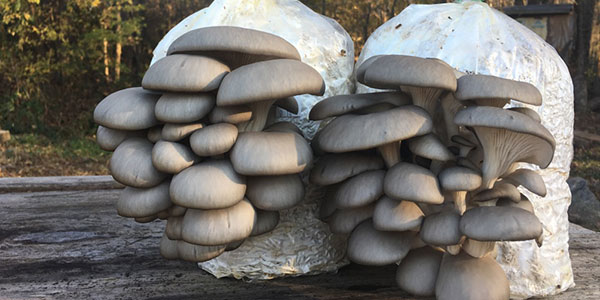
When growing oyster mushrooms, colonizing and fruiting temperatures range from 30-80 F. With the exception of cold blue oyster mushrooms. They enjoy colder climates and need a “frost shock” to begin fruiting. And species like the Flamingo and Pink Oyster fruit in warmer weather. Some species like the True Elm are considered to have a wide range of temperatures that it will colonize and fruit in.
Oyster mushrooms tend to be the one of the easiest mushrooms to cultivate due to how fast they grow, the wide variety of substrates as well as their tolerance to different growing conditions, can also be grown indoors ALL YEAR LONG.
For tips on how to grow oyster mushrooms, please reference our blog on this subject.
Oyster Mushroom Strains
Below please find a description for each of the oyster mushroom stains that we carry in our lab. Hope you enjoy 🙂
Aspen Oyster

(Pleurotus populinus) a hardwood loving strain with a colonization range of 70-75 F and a fruiting temperature of 60-74 F (spring and summer) this strain came from the woods in Maine found growing on aspen trees.
These mushrooms are mostly found at higher elevations. The also like other types of poplar trees like cottonwood, alder, birch, and even sometimes conifer trees. The cap can be dark brown to light brown depending on the temps. The warmer it is, the lighter the cap will be.
Of course if you are cultivating indoors, and you don’t give the mushrooms enough light, their caps will have lighter colors. It features an intoxicating anise aroma, and have a very delicate flavor. They don’t last long after you pick them, so eat them within a few days of harvesting.
Colonization Temps: 70-75F
Fruiting Temps: 60-74F
Click below for spawn availability
Oyster Mushroom Sawdust Spawn
Oyster Mushroom Plug Spawn
King Black Pearl Oyster
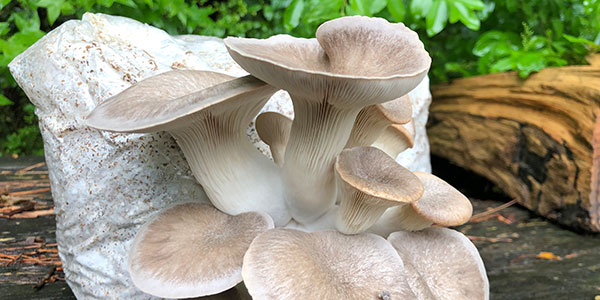
(Pleurotus ostreatus) a hardwood loving commercial strain that’s a pearl oyster hybrid, colonizes around 65-75 F and fruits anywhere between 50-68 F.
According to Superior Mycology, these guys combine the robust flavor of regular mushrooms and the firm texture of king oysters. It was developed a couple of years ago in Japan by hybridizing king oyster and regular oyster mushrooms. The name it got is Shimofuri Hiratake which translates to Marbled Oyster Mushroom. According to Mountaintop Mushrooms, it has a beautiful umami flavor, great in Asian dishes like stir fries or soups.
Lovely tender, meaty stems great for sauteeing and grilling, it would hold its shape very nicely when pickled or fermented. It is extremely versatile, has great texture and packed full of flavor, it also yields very well and has a great shelf life. It is an excellent meat replacement.
Colonization Temps: 70-75F
Fruiting Temps: 50-68F
Click below for spawn availability
Oyster Mushroom Sawdust Spawn
Oyster Mushroom Plug Spawn
Brown Oyster
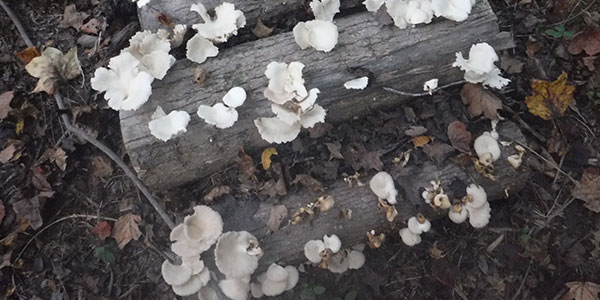
(Pleurotus ostreatus) Local to South Carolina, this hardwood loving strain is photosensitive and should be grown in opaque bags if cultivated in substrates other than logs. Fruits very well on oak, sweet gum and poplar poplar usually during spring and fall when temperatures are around 50-75F. Very similar to the native white oyster, this strain differs in that it has a softer, inflated stem that is edible! The entire mushroom can be sliced and cooked, making it a great value for consumers. This strain can grow to almost a foot across and the cap margin becomes a beautiful, wavy shape when mature. It can be oiled and grilled whole for oyster sandwiches or cubed up and threaded onto kabobs.
Colonization Temps: 70-75F
Fruiting Temps: 50-75F
Click below for spawn availability
Oyster Mushroom Sawdust Spawn
Oyster Mushroom Plug Spawn
Brown POHU Oyster
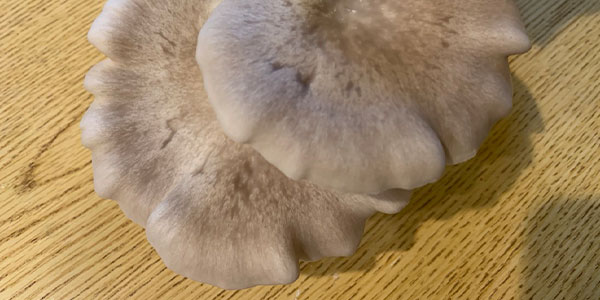
(Pleurotus ostreatus) – This is a Hungarian variety of brown mushrooms also a hardwood loving strain. This strain is photosensitive and should be grown in opaque bags if cultivated in substrates other than logs.
Colonization Temps: 70-75F
Fruiting Temps: 50-75F
Click below for spawn availability
Oyster Mushroom Sawdust Spawn
Oyster Mushroom Plug Spawn
Mulberry Oyster
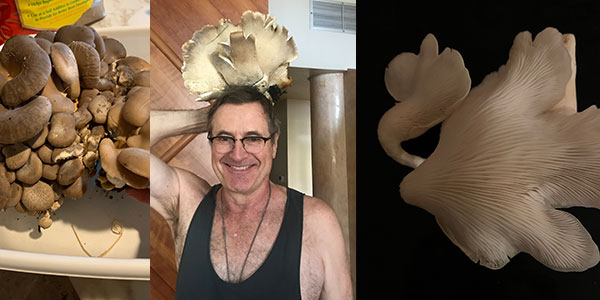
(Pleurotus ostreatus) – This strain was found by my friend Mickey. He sent me a dried sample of it, and we cultured its mycelium here at Mushroom Mountain last year. Super productive species with dark and thick caps. It is a form of a brown oyster. Absolutely gorgeous. Here is the email he sent me 🙂
“It has been snowing, down to the 20s and this thing just keeps fruiting! My wife Gloria tells me this is the seventh flush this year come off all of them about this size or bigger.
It is growing from the base of a fruiting mulberry tree we cut down, surrounded by scoria/pumice rock into which the mycelium often infiltrates so you have to be careful not to nick your knife when cutting them to cook them.
Astoundingly productive.”
He also sent me a follow up email about it one day:
“Yes, it was a healthy fruiting mulberry we cut down because it littered the yard with berries and the renters complained that their dog tracked purple stains inside – so yes, there’s lots of food there for it.
Fruiting Temps: 20-85F
Warm Blue Oyster
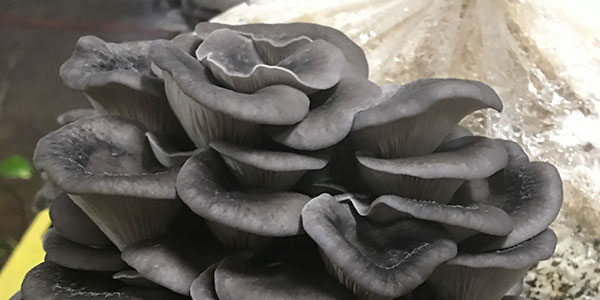
(Pleurotus ostreatus) is one of our most prolific indoor commercial fruiting strains with an extremely WIDE fruiting temperature window. Meaty and sweet, this mushroom is also known for its antiviral properties as well as cholesterol lowering abilities. Optimum fruiting occurs when temperatures between 50-80F, but it can produce as high as 95F. Outdoors it fruits well on oak, sweetgum, poplar, and many other hardwood species. Indoors we recommend fruiting this strain on pasteurized wheat straw and cotton hulls for incredible yields. We grow this strain year-round indoors and it forms beautiful, thick clusters. The blue color quickly fades into a light steel-blue, grey color.
Colonization Temps: 70-75F
Fruiting Temps: 50-80F
Click below for spawn availability
Oyster Mushroom Sawdust Spawn
Oyster Mushroom Plug Spawn
Cold Blue Oyster
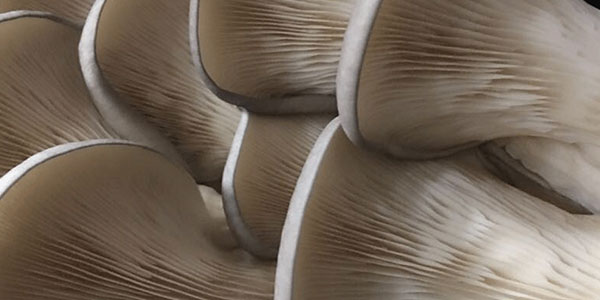
(Pleurotus ostreatus) local to South Carolina this strain fruits at temperatures ranging from 35-50F and needs a cold shock to induce the fruiting stage.
Colonization Temps: 70-75F
Fruiting Temps: 30-50F
Click below for spawn availability
Oyster Mushroom Sawdust Spawn
Oyster Mushroom Plug Spawn
Golden Oyster
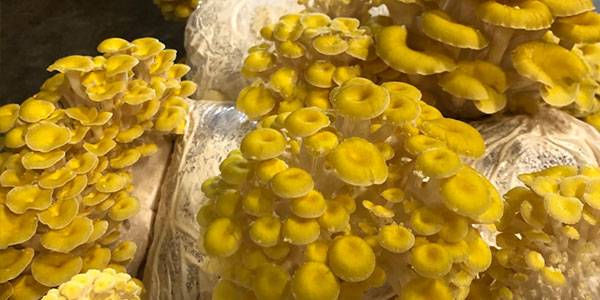
(Pleurotus citrinopileatus) One of our most beautiful oyster species, this cool to warm weather strain is VERY FRAGILE when mature. They resemble a bouquet of beautiful yellow flowers, smell like fresh watermelon, and taste like roasted cashews when you saute them in oil. This is a vibrantly yellow to golden colored strain that fruits around 74-90F.
Colonization Temps: 70-75F
Fruiting Temps: 74-90F
Click below for spawn availability
Oyster Mushroom Sawdust Spawn
Oyster Mushroom Plug Spawn
Grey Dove
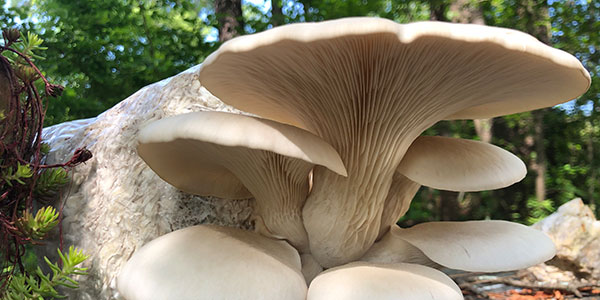
(Pleurotus ostreatus) This strain colonizes well on straw and hardwoods. It is a sturdy clustering mushroom, colors varying from deep blue when they start out as pins, to a grey blue when it matures. Great taste on this one. This is a good one to plant in an unheated greenhouse on straw in cold weather.
Colonization Temps: 70-75F
Fruiting Temps: 50-75F
Click below for spawn availability
Oyster Mushroom Sawdust Spawn
Oyster Mushroom Plug Spawn
King Oyster
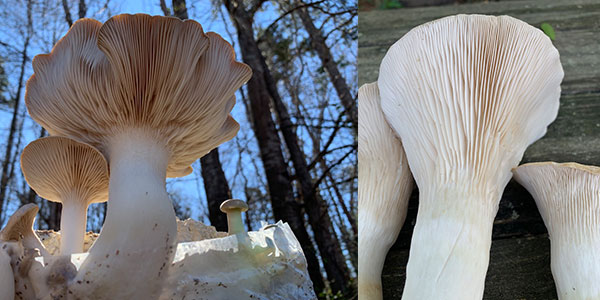
(Pleurotus eryngii) Largest mushroom in the oyster family, its shelf life is great, up to a week in refrigeration and it is cultivated widely around the world. King oyster, like most oyster mushrooms, are said to have originated on the shores of the Mediterranean Sea as well as parts of the Middle East and Northern Africa. Great substitute for seafood, you can cut the stem off these mushrooms into thick scallop like pieces and cook them just like you would scallops. Yummy for meat eaters, vegeterians and vegans. Check out this recipe on Mushroom Council: https://www.mushroomcouncil.com/recipes/trumpet-mushroom-scallops-with-brown-butter-and-thyme/
Colonization Temps: 68-71F
Fruiting Temps: 59-64F
Click below for spawn availability
Oyster Mushroom Sawdust Spawn
Oyster Mushroom Plug Spawn
Elf Oyster
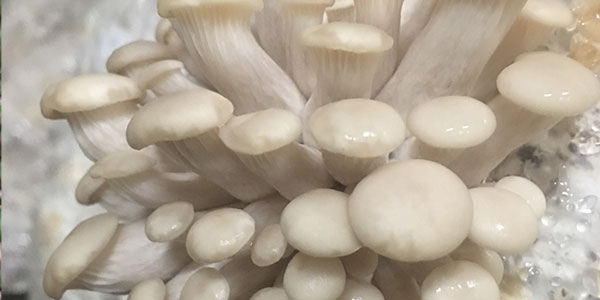
(Pleurotus nebrodensis) This is an endangered species native to northern Sicily. Other common names for it are Nebrodini and Abalone. The fruiting body is creamy white, and it is closely related to the King Oyster. The mushrooms are velvety when cooked, earthy and buttery in texture. They also feature a slight peppery taste to them.
Colonization Temps: 65-78F
Fruiting Temps: 55-60F
Click below for spawn availability
Oyster Mushroom Sawdust Spawn
Oyster Mushroom Plug Spawn
Pearl Oyster
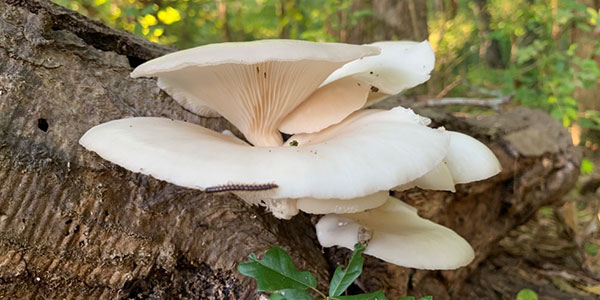
(Pleurotus ostreatus) – This strain of the oyster mushrooms is usually white, but it can vary anywhere from white to gray to brown. It is a common temperate oyster mushroom, and it can grow on many different substrates like paper, cardboard, straw, sterilized sawdust and other agricultural waste. They produce gorgeous firm medium sized clusters.
Colonization Temps: 70-75F
Fruiting Temps: 60-70F
Click below for spawn availability
Oyster Mushroom Sawdust Spawn
Oyster Mushroom Plug Spawn
Pink Oyster
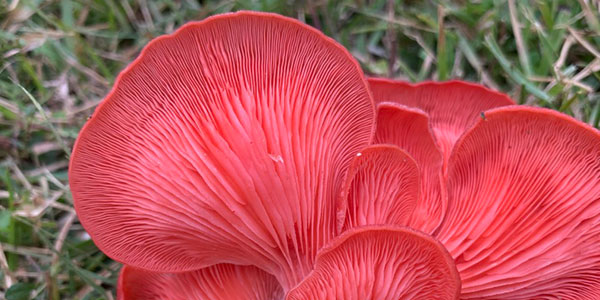
(Pleurotus djamor) – This tropical oyster mushroom is a stunning pink color and resembles the flavor of seafood, making it a big hit with chefs and market buyers. We grow this mushroom during the warmer months indoors under blue LED lights and the caps are almost brilliant RED! This mushroom should be picked young, as they age the fragrance intensifies and is less desirable, and the color fades too as they enlarge, so we prefer to pick these mid-way through maturity and they store much better than older fruitbodies. We recommend fruiting this strain on pasteurized wheat straw and cotton hulls for substantial yields when others are going dormant in the extreme heat of the summer.
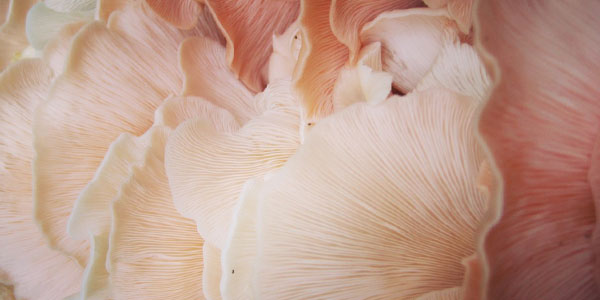
Can be grown year-round indoors or intercropped with greenhouse plant production in tropical climates and can fruit in as little as 7-10 days at temperatures around 85-90F! We also use this mushroom for classroom activities since they fruit very quickly for students and teachers to observe. This will also grow on cardboard, paper and coffee grounds. The flavor of the pink oyster mushroom has been described as meaty and “seafoody”. Just like most mushrooms it is quite umami. Its texture is both meaty and chewy. When fried until crispy, it resembles bacon or even ham. This mushroom fruits between April and December and usually has a short shelf life so it is a rare one to see at super markets.
Colonization Temps: 70-75F
Fruiting Temps: 75-95F
Click below for spawn availability
Oyster Mushroom Sawdust Spawn
Oyster Mushroom Plug Spawn
Flamingo Oyster
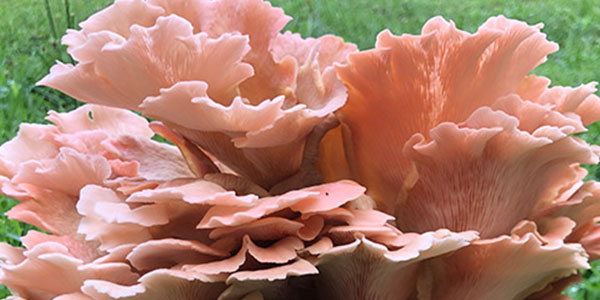
(Pleurotus salmoneo-stramineus) The mycelium of this oyster mushroom species is very robust and therefore very popular in commercial cultivation. Fruiting bodies become 5 to 15 cm in diameter. The cap is bright pink when young and loses some color as it matures.
Colonization Temps: 70-85F
Fruiting Temps: 75-98F
Click below for spawn availability
Oyster Mushroom Sawdust Spawn
Oyster Mushroom Plug Spawn
Phoenix Oyster

(Pleurotus pulmonarius) are the true summer oyster, that prefer warmer temperatures and can be distinguished from white-spored P.ostreatus with their beautiful lilac colored spore-prints. Most strains have all white fruit bodies, and this one is no exception. This strain was originally isolated from the ID tables at Oconee State Park, South Carolina growing out of a Virginia Pine branch. It will fruit on conifer wood, but the mushrooms are small. It prefers to fruit on hardwoods or can be grown on pasteurized agricultural waste, such as straw or cotton. This culture is great for mycoremediation projects and can also convert piles of conifer mulch and stumps into soil, and has shown high activity in breaking down herbicides. This mushroom is a treat to eat, has a soft, velvety and sweet flavor reminiscent of anise and is super easy to grow during the warmer months of the year!
Colonization Temps: 70-75F
Fruiting Temps: 75-95F
Click below for spawn availability
Oyster Mushroom Sawdust Spawn
Oyster Mushroom Plug Spawn
Tarragon Oyster
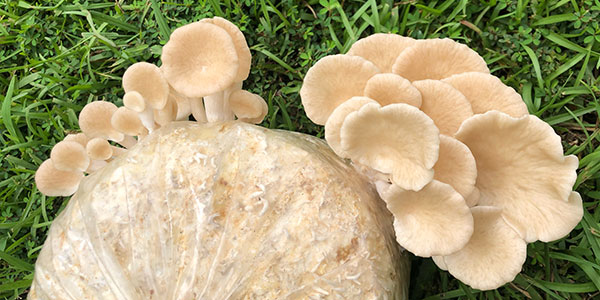
(Pleurotus euosmus) a rare oyster mushroom found in the British Isles. With a distinctive trumpet shaped cap, as its name suggests, its smell and taste resembles the herb tarragon, making it probably the finest tasting oyster mushroom there is. This may be one of the richest tasting oysters that we have had yet! This tasty mushroom smells slightly like anise and has a marbling of light grey on white. It grows a lot like P. ostreatus, with a cap that is curved outward and later on becomes depressed in the center. These mushrooms are generally very brittle so you’ll want to be gentle harvesting them.
The gills are long and decurrent, running down the mushroom to the stem. The stem is short or sometimes it may not be present at all. It is edible down to its stem which is a little fibrous if eaten. It grows on a variety of growth mediums including, hardwood logs, coffee waste, cottonseed hulls, straw and hardwood sawdust. You can also experiment with different growth mediums and see what it grows on, you would be surprised at the number of things you can produce these mushrooms on! After full colonization you can expect to see fruiting bodies develop after around 4-8 days. If you are cultivating these mushrooms indoors you can expect about 3 flushes around two weeks apart. You can expect this mushroom to fruit in temperatures varying between 70-80 degrees however we have had it fruit at temperatures below that it just didn’t yield as much.
Colonization Temps: 70-80F
Fruiting Temps: 70-90F
Click below for spawn availability
Oyster Mushroom Sawdust Spawn
Oyster Mushroom Plug Spawn
Sporeless Brown Oyster
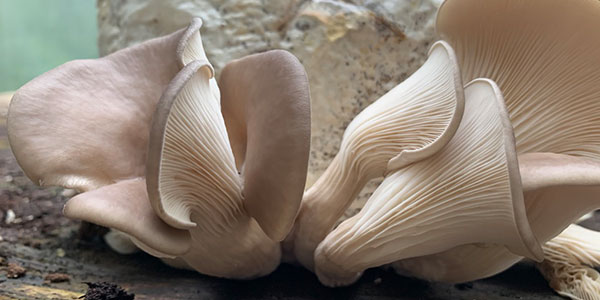
(Pleurotus ostreatus) This is a brown oyster mushroom strain that doesn’t produce spores. It was developed as an experiment by crossing strains of oyster mushrooms. This strain is promising for large farms where sporeloads can be problematic for workers. Large amounts of spores floating around in workspaces can cause lung problems.
Colonization Temps: 70-80F
Fruiting Temps: 55-75F
Click below for spawn availability
Oyster Mushroom Sawdust Spawn
Oyster Mushroom Plug Spawn

16 thoughts on “Which Oyster Mushroom Should I Choose to Cultivate and Other Useful Facts”
Which would you recommend for outdoor beds in zone 9a (north Florida)?
All would work in your area 🙂 My favorites are warm blue and tarragon.
HELLO. IS DOGWOOD A GOOD TREE to grow shiitake and oyster?
Thank you!
Dogwood could be OK for oysters, but I have not heard anyone growing shiitake on dogwood.
HELLO. IS DOGWOOD A GOOD TREE to grow shiitake and oyster?
THank you!
Now i know growing oyster mushrooms is possible and I don’t need to drive all over the country side looking up and down trees for them. In the Fall myself and parents would drive for hrs and miles in search for them sometimes we found plenty and times 0 thank you my parents are gone now tooo late
awwwwwww, but I bet it was an amazing experience foraging with. your parents. For me growing them is fun, but when you find them it is something extra special. 🙂
Which OYSTERS are good outdoors in PA?
Thanks
Anything other than heat only tolerant varieties like the pink oysters.
Nice article.thanks